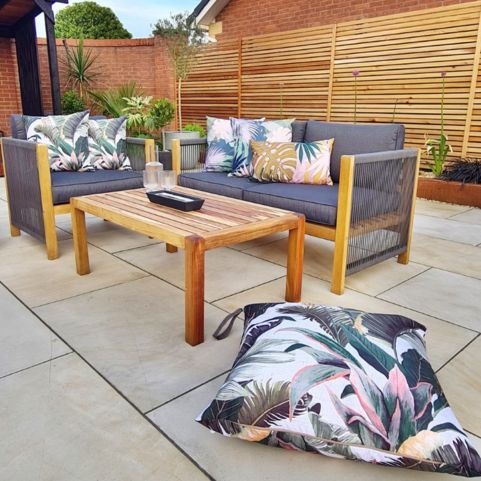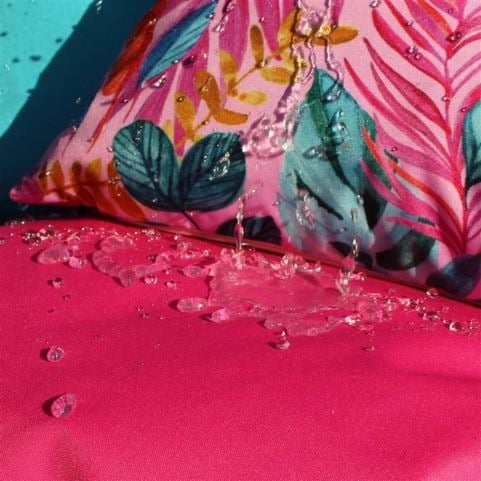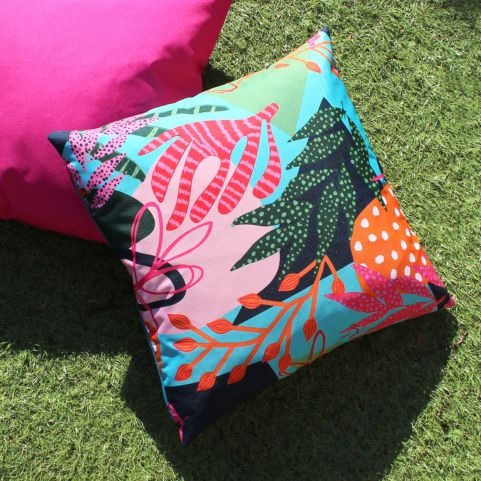Our watertight guide to keeping your outdoor cushions happy.
Have you ever tried to figure out if your outdoor cushions are waterproof, only to end up feeling like there’s some sort of cushion-clad conspiracy going on? No matter what source you use or which website you turn to, there seems to be a lot of confusion, and a noticeable grey area around what the term ‘waterproof’ even means.
In the interest of transparency – and keeping your cushions clear of any water-related mishaps – we’ve decided to take matters into our own hands. So, whether you’re dreading your cushions getting caught in a downpour, are unsure of where to store them through winter, or simply don’t want to spend your life stressing over how enthusiastic you’re being with the garden hose – we’re bringing you a watertight guide to what exactly your outdoor cushions can handle.
Before we deep-dive into just how much water your outdoor cushions can handle, let’s start with the basics, shall we? The Merriam-Webster online dictionary defines the term ‘waterproof’ as relating to anything which is “impervious to water” or “covered or treated with a material (such as a solution of rubber) to prevent permeation by water”.
This essentially means that a material or fabric must be completely immune to water damage if it’s to be considered waterproof. Even the heaviest of spills, the most torrential of downpours and full submersion in a pool of water will not break the barrier of waterproof fabric.
Now that we’re all on the same page as to what’s meant by waterproof, let's clearly define some of the other terms that cause confusion with waterproof fabrics:
Shower proof
The term ‘shower proof’ is generally used for cushions and fabrics that can only withstand low levels of water exposure. The hint is in the name, as a light spring shower or gentle splash from the paddling pool is about as much water as these fabrics can handle.
A big spill or heavy rain will soak right through to the inner pad of shower proof cushions, causing them to become fertile ground for mould and mildew if not thoroughly dried out.
Water resistant
A term we use a lot when talking about our outdoor rugs and cushions, ‘water resistant’ fabrics can resist brief exposure to water, but will become damaged if soaked or submerged.
There’s no need for a high-octane rescue mission to the garden if your water resistant cushions get caught in a drizzle, but you should avoid leaving them out for prolonged periods. While they’re less likely to become host to mould and mildew, it’s still possible if they’re not aired out and placed in a warm spot after getting wet.
Weatherproof
'Weatherproof’ fabrics are designed to withstand exposure to the elements. As well as resisting prolonged exposure to water, you don’t have to worry about weatherproof cushions fading or losing colour in the sun, either.
As long as you avoid leaving them out in extreme weather for long periods – you can tick damp, mould, waterlogging and sun-fading off your list of worries when it comes to weatherproof cushions.
One thing quickly becomes clear when you start looking into outdoor fabrics – nothing keeps out water like a fully waterproof cushion. Waterproof fabrics are the clear winners when it comes to keeping dry – so they’re obviously the best choice for your outdoor cushions, right? …right?
No, not necessarily. As Furn interior expert Suzi explains, "fully waterproof cushions often come with a layer of plastic sealant, so they aren’t always the best choice for comfort and breathability. Sticking with water resistant fabrics will give you a plush alternative that stills stands up to splashes and spills".
Outdoor cushions need to be treated with a special plastic coating – usually made from PVC – in order to become fully waterproof. This coating generally covers the back or bottom side of the cushion, and physically prevents water from passing through to the foam inner pad. While this works great for keeping your cushions dry and fresh, you might not be so pleased once you decide to sit down.
The plastic coating blocks water passing through the fabric, but an unfortunate side effect is that it also blocks air. This is why fully waterproof fabrics often lack breathability, leaving you hot, bothered and generally uncomfortable after a lengthy sit. Having to peel your outdoor cushion from the back of your legs is enough to spoil anyone’s barbecue, so you might want to think twice before settling on a fully waterproof option.
We recommend outdoor cushions that are resistant to both water and UV rays for the ultimate combination of comfort and durability. They’re more than capable of handling the peaks and troughs of British weather, while being the only option with protection against both rain and sun. All of our outdoor cushions are designed to resist everything from spills and splashes, to showers and the scorching summer sun.
"At Furn, we have chosen to mix style with a durable finish" Suzi explains. "We wanted to print our outdoor cushions for that individual feel. Our solid colours are bright and impactful, something you don't always get with heavy waterproof versions".
Can you leave garden furniture cushions outside? No, you can't. No matter how water resistant or waterproof an outdoor cushion is, it will get damaged if left out in bad weather for too long. As long as you remember to bring your outdoor cushions inside during heavy rain and store them in a clean, dry area during winter – you can keep your outdoor cushions fresh for many a summer soirée to come.
Waterproof cushions do their job well, but we don’t recommend using one unless you’re living in a particularly rainy climate or plan on exposing your cushion to heavy streams of water.
"Waterproof cushions are not for everyone" Suzi advises. "Water resistant cushions are the ideal happy medium. They offer all the comfort of a regular scatter cushion, while doing a great job of keeping water out".
What you gain in water resistance, you lose in comfort with fully waterproof cushions. Water resistant cushions are more than capable of handling moderate climates like the UK’s, so there’s really no need to go with a fully waterproof design.
.jpg?v=1688134609190)



















